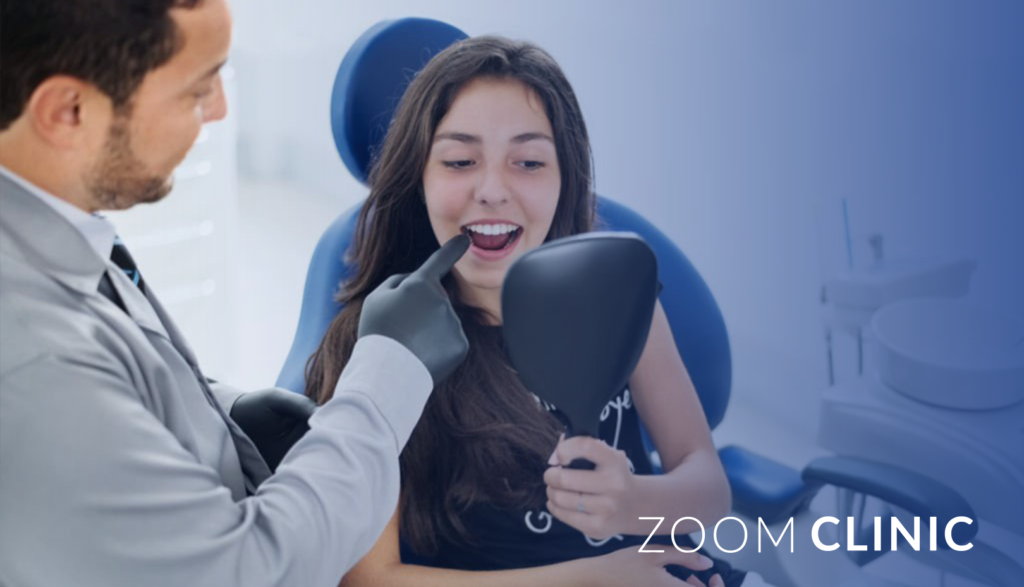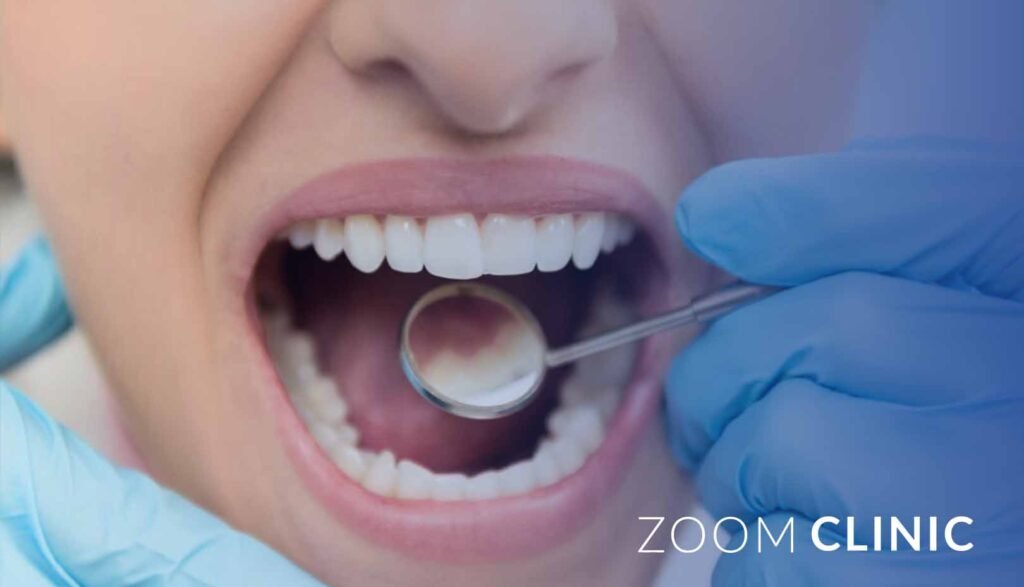Immediate dental implants are an innovative approach within implant dentistry that allows for an implant placement immediately following a tooth extraction.
This technique reduces treatment time and preserves the alveolar bone structure, offering functional and aesthetic benefits.
Immediate implants are a popular solution for missing teeth, providing patients with a faster alternative to delayed implant placement.
Table of content
What Are Immediate Dental Implants?
Immediate dental implants involve placing a dental implant at the extraction site within a week or ten days after the tooth extraction is completed.
Unlike the traditional delayed approach, where implant placement is postponed to allow the bone and soft tissues to heal, immediate implants aim to speed up the process by utilizing the existing alveolar bone for support.
This approach reduces the time between tooth loss and the insertion of a replacement tooth, enhancing the procedure’s efficiency and outcome.
Benefits of Immediate Implants

- Reduced Treatment Time
Immediate implant placement minimizes the total treatment time compared to delayed approaches, where healing can take several months before the dental implant can be placed. Placing the implant immediately after extraction saves patients time and avoids multiple surgical visits. - Preservation of Alveolar Bone and Surrounding Bone Tissue
Immediate implants help maintain alveolar bone structure and prevent bone loss, which is standard after tooth extraction. The implant is a substitute root, stimulating the bone and supporting the surrounding tissues, leading to better long-term oral health outcomes. - Enhanced Aesthetic Outcome
Immediate implants contribute to a natural look by maintaining the original contours of the soft tissues around the extraction site. This is particularly beneficial for single-tooth implants in visible areas, like the maxillary anterior, where aesthetics play a significant role. - Primary Stability
Placing the implant immediately after extraction helps achieve primary stability by utilizing the surrounding bone tissue. This stability is essential to the success of the implant and minimizes the likelihood of implant failure.
The Immediate Dental Implant Procedure: Step-by-Step
Initial Consultation
During the initial consultation, the dentist assesses the condition of the tooth, alveolar bone, and surrounding tissue. Diagnostic tests, including X-rays or CBCT scans, are conducted to evaluate bone density and suitability for immediate implant placement.
Tooth Extraction and Implant Placement
Once the extracted tooth is removed, the implant is placed directly into the extraction socket. This step requires precise measurements to ensure proper implant insertion and integration into the surrounding bone tissue.
Bone Grafting (If Needed)
In some cases, bone density may be insufficient, especially if bony defects are present. Bone grafting is sometimes performed to provide additional support and improve implant stability.
Healing and Integration
Following the procedure, a healing period allows the implant to integrate with the bone. During this time, peri-implant mucosa and soft tissues undergo healing, supporting the implant and creating a stable foundation.
Final Crown Placement
After successful osseointegration, the final crown or replacement tooth is attached to the implant, restoring the patient’s smile and function.
Immediate vs. Delayed Implant Placement

Immediate implants offer faster results and help prevent bone loss.
In contrast, delayed implants allow more time for soft tissue healing and may be more suitable in cases where implant primary stability is uncertain.
The choice between immediate and delayed implants depends on bone density, oral health, and the patient’s needs.
Immediate vs. Delayed Implant Placement: Pros and Cons
Immediate Implant Placement
- Pros: Shorter treatment time, preserves bone structure, and enhances aesthetic outcomes.
- Cons: Requires high primary stability and may not be suitable for patients with insufficient bone.
Delayed Implant Placement
- Pros: Allows complete bone healing and may achieve more excellent implant stability in cases of bone deficiency.
- Cons: Prolong treatment time and may require additional bone grafting.
Risk of Implant Failure and Ways to Mitigate It
As with any dental implant procedure, there is potential for failure. Failure is often related to a lack of primary stability, infection, or insufficient bone density.
To reduce risks, implant dentistry professionals assess factors like soft and hard tissue quality, ensuring adequate bone for implant stability.
Factors That Affect Success in Immediate Implants

- Bone Quality and Density
High-quality bone with good density supports primary stability, which is essential for the success of immediately loaded implants. - Surrounding Soft and Hard Tissues
Healthy soft tissues and adequate bone augmentation can enhance implant stability and reduce the risk of implant failure. - Oral Hygiene and Health
Maintaining oral health is crucial, as gingival tissues and peri-implant mucosa must be inflammation-free for successful implant integration.
The Role of Bone Grafts and Connective Tissue Grafts
Bone grafts may be used when there is inadequate bone to support the implant, especially if bone loss has occurred before the implant placement.
Connective tissue grafts are sometimes used to improve soft tissue thickness and health around the implant site, enhancing the aesthetic outcome and longevity of the implant.
Common Areas for Immediate Implants
Maxillary Anterior Region
The maxillary anterior is a common location for immediate implants due to its high aesthetic demand. This area requires careful consideration of soft tissue healing and implant placement to ensure a natural look.
Single Tooth Replacement
Immediate implants are often used to replace single teeth in visible areas, providing an instant aesthetic solution and helping to maintain adjacent teeth in their natural positions.
Posterior Teeth with Sufficient Bone Support
Immediate implants are also suitable for posterior regions, provided sufficient alveolar bone and implant stability can be maintained.
Immediate Implants and Prosthetic Treatment
Prosthetic treatment for immediate implants includes attaching a temporary or permanent crown to the implant.
This final step completes the implant restoration, giving patients a functional and aesthetic solution to their missing teeth.
Temporary Crowns
Placing a temporary crown immediately after implant insertion helps support soft tissue healing and maintains the aesthetic structure of the gum line.
Permanent Crowns
A permanent crown is attached once the implant fully integrates, restoring function and appearance.
How to Care for Immediate Implants
Maintain Excellent Oral Hygiene
Regular brushing, flossing, and professional cleanings prevent infection and support healing.
Avoid Hard and Crunchy Foods
Immediately after the implant procedure, patients should avoid foods that may damage the implant site or surrounding bone.
Regular Follow-Up Appointments
Follow-up visits ensure that the implant is healing well and that implant stability is maintained over time.
Advanced Techniques and Innovations in Immediate Implants
Modern implant dentistry incorporates advanced materials and technologies that improve the success of immediate implants.
For instance, titanium implants with specialized surfaces enhance implant stability and reduce the risk of implant failure. Digital imaging and 3D printing technology allow precise implant placement, minimizing complications and improving outcomes.
Key Considerations Before Choosing Immediate Implants

- Bone Density and Quality
A thorough bone quality and density evaluation is essential to determine whether the patient is a good candidate for immediate implants. - Health of Surrounding Tissues
Healthy gingival tissues and peri-implant mucosa support the implant and ensure long-term success. - Patient’s General Health
Conditions like diabetes or smoking habits may affect healing and should be considered when planning for immediate implants.
Advanced Techniques: Bone Grafts and Connective Tissue Grafts
Bone Grafts: Bone grafting is commonly used in cases where there is insufficient bone to support an implant, especially if bone resorption occurs. This procedure enhances the implant site and supports long-term success by building a stable foundation.
Connective Tissue Grafts: These grafts improve soft tissue health around the implant, particularly for patients with thin or compromised tissue. Connective tissue grafts enhance aesthetics and provide extra support to prevent implant exposure.
Ideal Candidates for Immediate Implants
Immediate implants are typically best suited for patients who:
- Have adequate bone density to support primary stability.
- Possess good oral health, free from infections or gum disease.
- Are non-smokers since smoking can hinder implant healing.
- Maintain excellent oral hygiene to support long-term implant success.
Innovations and Future Trends in Immediate Implants
3D Imaging: 3D imaging technologies aid in accurate implant planning and placement, improving precision and reducing potential complications. This helps in creating customized solutions for each patient.
Surface Treatments: Modern titanium implants have advanced surface treatments that enhance osseointegration by encouraging faster and more secure bone integration, minimizing implant failure risk.
Immediate Loading Techniques: Innovations allow some patients to receive temporary crowns on the same day as the implant placement, provided primary stability is met. This immediate loading shortens the process while achieving both aesthetic and functional outcomes.
Conclusion
Immediate dental implants provide an effective, time-saving option for patients looking to replace missing teeth quickly and efficiently.
Removing the implant directly into the extraction socket, immediate implants help preserve alveolar bone, reduce treatment time, and offer an aesthetically pleasing solution.
Although immediate implants may not be suitable for everyone, their benefits in terms of primary stability, reduced bone loss, and quicker recovery make them an excellent choice for many patients.
Patients considering immediate implant placement should consult a dental implant professional to assess suitability, discuss treatment options, and plan for a smooth recovery.
With proper care, immediate dental implants can offer a long-lasting solution, restoring function and aesthetics to missing teeth while supporting oral health.
Get the special offer today from Zoom Clinic
Related Articles:
Types of German Implants in Türkiye
The Pros and Cons of Dental Implants in Turkey
FAQs on Immediate Dental Implants
What are immediate dental implants?
Immediate dental implants are placed directly into the extraction socket immediately after a tooth is removed, unlike delayed implants, where the implant placement is postponed to allow the site to heal fully. This technique reduces the number of procedures and minimizes treatment time. Immediate implants also help preserve alveolar bone and soft tissue, maintaining the natural structure and preventing bone loss. This approach is commonly used in aesthetic areas or for single-tooth replacements to achieve a quicker restoration.
How long does the procedure for immediate dental implants take?
The procedure typically requires 1–2 hours for each implant, including extraction and placement. However, full healing, known as osseointegration, where the implant fuses with the bone, may take 3–6 months. A temporary crown or denture may be provided during this healing phase for aesthetics and function. The final crown placement occurs once the implant has fully integrated, completing the restoration. Though the initial surgery is quick, a patient should plan for an extended timeline due to the healing period.
Who is a good candidate for immediate implants?
Ideal candidates for immediate implants are those with sufficient bone density to ensure initial stability. Other ideal conditions include good overall health, excellent oral hygiene, and no active gum disease or infections. Non-smokers tend to have better outcomes, as smoking can impact healing. Immediate implants may also work well for patients looking to replace single teeth, particularly in areas visible when smiling. A dental consultation with imaging will help determine suitability, assessing bone density and general oral health.
Are immediate implants more prone to failure than delayed implants?
Immediate implants have comparable success rates to delayed implants when primary stability is achieved. However, immediate placement can be riskier in cases with low bone density, as primary stability may be challenging. To minimize the chance of implant failure, surgeons ensure adequate bone support and healthy surrounding tissues before proceeding. Regular follow-ups, proper oral hygiene, and avoiding stress on the implant during the healing phase also contribute to a high success rate.
Do immediate implants require bone grafting?
Bone grafting is not always required but is necessary if there isn’t enough bone to support the implant. This can occur if there’s been previous bone resorption or an existing bony defect. A bone graft may be placed alongside the implant or as a preliminary procedure to build a stable foundation in these cases. The need for a bone graft is assessed during the initial consultation through X-rays or 3D scans, allowing the dentist to fully evaluate bone density and quality.
What is immediate dental implant placement?
Immediate dental implant placement is a technique where the dental implant is inserted directly into the extraction socket immediately following a tooth extraction. This approach contrasts with the traditional delayed placement, which waits several months post-extraction for the area to heal. Immediate placement leverages the existing alveolar bone structure, providing a stable foundation while minimizing the risk of bone loss. It is beneficial for single-tooth replacements, particularly in the aesthetic regions, as it can reduce treatment time and maintain soft tissue contours.


